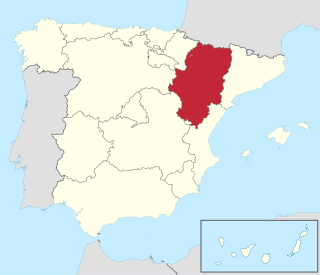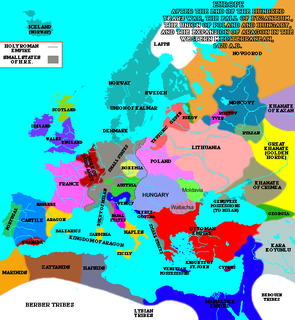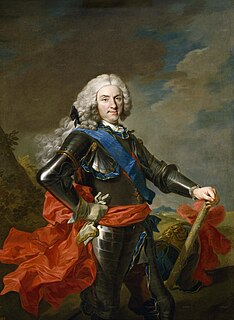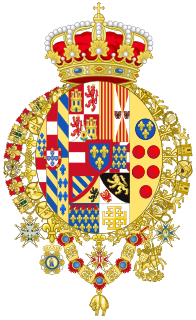
Catherine of Aragon was Queen of England as the first wife of King Henry VIII from their marriage on 11 June 1509 until their annulment on 23 May 1533. She was previously Princess of Wales as the wife of Henry's elder brother, Arthur, Prince of Wales.

Aragon is an autonomous community in Spain, coextensive with the medieval Kingdom of Aragon. In northeastern Spain, the Aragonese autonomous community comprises three provinces : Huesca, Zaragoza, and Teruel. Its capital is Zaragoza. The current Statute of Autonomy declares Aragon a historic nationality of Spain.

Year 1470 (MCDLXX) was a common year starting on Monday of the Julian calendar.

Philip V was King of Spain from 1 November 1700 to 14 January 1724, and again from 6 September 1724 to his death in 1746. His total reign of 45 years is the second longest in the history of the Spanish monarchy. Philip instigated many important reforms in Spain, most especially the centralization of power of the monarchy and the suppression of regional privileges, via the Nueva Planta decrees, and restructuring of the administration of the Spanish Empire on the Iberian peninsula and its overseas regions.

Cervera is the capital of the comarca of Segarra, in the province of Lleida, Autonomous Community of Catalonia, Spain. The title Comte de Cervera is a courtesy title, formerly part of the Crown of Aragon, that has been revived for Leonor, Princess of Asturias. The city is also the birthplace of the Grand Prix motorcycle racing world champions Márquez brothers, eight-time champion Marc Márquez and two-time champion Álex Márquez. The church of Sant Miquel de Tudela is near Cervera.

Charles II of Spain, known as the Bewitched, was the last Habsburg ruler of the Spanish Empire. Best remembered for his physical disabilities and the War of the Spanish Succession that followed his death, Charles's reign has traditionally been viewed as one of managed decline. However, many of the issues Spain faced in this period were inherited from his predecessors and some recent historians have suggested a more balanced perspective.
A personal union is the combination of two or more states that have the same monarch while their boundaries, laws, and interests remain distinct. A real union, by contrast, would involve the constituent states being to some extent interlinked, such as by sharing some limited governmental institutions. Unlike the personal union, in a federation and a unitary state, a central (federal) government spanning all member states exists, with the degree of self-governance distinguishing the two. The ruler in a personal union does not need to be a hereditary monarch.

The Kingdom of Aragon was a medieval and early modern kingdom on the Iberian Peninsula, corresponding to the modern-day autonomous community of Aragon, in Spain. It should not be confused with the larger Crown of Aragon, which also included other territories — the Principality of Catalonia, the Kingdom of Valencia, the Kingdom of Majorca, and other possessions that are now part of France, Italy, and Greece — that were also under the rule of the King of Aragon, but were administered separately from the Kingdom of Aragon.

The Crown of Aragon was a composite monarchy ruled by one king, originated by the dynastic union of the Kingdom of Aragon and the County of Barcelona and ended as a consequence of the War of the Spanish Succession. At the height of its power in the 14th and 15th centuries, the Crown of Aragon was a thalassocracy controlling a large portion of present-day eastern Spain, parts of what is now southern France, and a Mediterranean empire which included the Balearic Islands, Sicily, Corsica, Sardinia, Malta, Southern Italy and parts of Greece.

The Habsburg monarchy, also called the Danubian monarchy, or Habsburg Empire, was the collection of lands and kingdoms of the Habsburg dynasty, especially for those of the Austrian line. In historiography, the terms Austria, Austrian and Austrians are frequently used as pars pro toto shorthand for the Habsburg monarchy. From 1438 to 1806, a member of the House of Habsburg was also Holy Roman Emperor. However, the states of the Holy Roman Empire ruled by their own dynasties are not considered to have been part of what is now called the Habsburg monarchy.

The Nueva Planta decrees were a number of decrees signed between 1707 and 1716 by Philip V, the first Bourbon king of Spain, during and shortly after the end of the War of the Spanish Succession by the Treaty of Utrecht.

In common parlance, the wives of Henry VIII were the six queens consort wedded to Henry between 1509 and his death in 1547. In legal terms, King Henry VIII of England had only three wives, because three of his marriages were annulled by the Church of England. However, he was never granted an annulment by the Pope, as he desired, for Catherine of Aragon, his first wife. Annulments declare that a true marriage never took place, unlike a divorce, in which a married couple end their union. Along with his six wives, Henry took several mistresses.

The coat of arms of Spain represents Spain and the Spanish nation, including its national sovereignty and the country's form of government, a constitutional monarchy. It appears on the flag of Spain and it is used by the Government of Spain, the Cortes Generales, the Constitutional Court, the Supreme Court, and other state institutions. Its design consists of the arms of the medieval kingdoms that would unite to form Spain in the 15th century, the Royal Crown, the arms of the House of Bourbon, the Pillars of Hercules and the Spanish national motto: Plus Ultra. The Monarch, the heir to the throne and some institutions like the Senate, the Council of State and the General Council of the Judiciary have their own variants of the coat of arms.

The flag of Sardinia, called the flag of the Four Moors or simply the Four Moors, represents and symbolizes the island of Sardinia (Italy) and its people. It was also the historical flag and coat of arms of the Aragonese, then Spanish, and later Savoyard Kingdom of Sardinia. It was first officially adopted by the autonomous region in 1950 with a revision in 1999, describing it as a "white field with a red cross and a bandaged Moor's head facing away from the hoist in each quarter".

The House of Bourbon-Two Sicilies is a cadet branch of the Spanish Bourbons that ruled Southern Italy and Sicily for more than a century in the 18th and 19th centuries. It descends from the Capetian dynasty in legitimate male line through Philippe de Bourbon, Duke of Anjou, a younger grandson of Louis XIV of France (1638–1715) who established the Bourbon dynasty in Spain in 1700 as Philip V (1683–1746). In 1759 King Philip's younger grandson was appanaged with the kingdoms of Naples and Sicily, becoming Ferdinand IV and III (1751–1825), respectively, of those realms. His descendants occupied the joint throne until 1861, claimed it thereafter from exile, and constitute the extant Bourbon-Two Sicilies family.

The Aragon Ballroom is a ballroom located in Chicago, Illinois, approximately 5 miles (8 km) north of downtown, in the Uptown neighborhood.

The House of Carafa or Caraffa is a noble Neapolitan family of Italian nobles, clergy, and men of arts, known from the 12th century.
The Spanish monarchs of the House of Habsburg and Philip V used separate versions of their royal arms as sovereigns of the Kingdom of Naples-Sicily, Sardinia and the Duchy of Milan with the arms of these territories.















